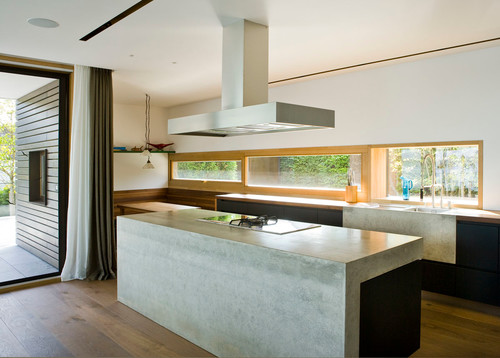Concrete has become a solid countertop alternative to stone and other materials in recent years. Innovators have played around with the consistency, colors, and textures to produce a variety of options, and none of them the boring cold gray you usually think of concrete as. In fact, they've become so good you can use them as a cheaper option than stone and get the same great look! One the best parts is you can make concrete countertops yourself, saving even more money in the process. Let's go over the necessary steps to make them!
- Draw out a plan with the proper dimensions and placements of the concrete countertops within your kitchen or bathroom.
- Build a frame for the concrete to set in. Use 3/4" melamine wood to build the frame. Melamine wood is good choice as it resists absorbing water, keeping your concrete wet while it settles.
- Tape up the edges of the frame and apply a bead of silicon around the edges, then smooth it down and take off the tape. Putting down the tape while applying the silicon makes for a consistent bead around the edges, keeping your countertop edges smooth.
- Now we get to the concrete. There are two parts to the mix: A. color and B. microfiber. Mix them both in a cement barrel and let stir for 10 minutes.
- While waiting for your cement, prep the form by put plastic underneath and cleaning it with alcohol to remove oils or dirt.
- When your cement's ready, dish it into the form. Smooth it out on top and pour in more if necessary. It's better to do too much than too little.
- Use an electric sander to vibrate the concrete and pop the air pockets. This will make for a balanced surface.
- Screed the top of the form to wipe off any excess concrete, then cover the concrete with plastic to keep in moisture. Let it cure for 10 days or until complete firm and dry.
- Once it's settled, unscrew and pry off the form from the concrete. Flip it over to see your concrete countertop nearly complete!
- At this point, you can stain your countertop for different colors with euratic acid, or you can settle for you current color and simply wax and buff the tops for their final look. If you choose to stain, use sample slabs before applying any to your countertop, as euratic acid works in an unpredictable way, its metallic salts reacting with the cement, and you can't know the colors until they're on and dry.
Those are the 10 steps to making your own concrete countertops! We hope you found this guide easy to follow and useful in your own DIY project. Watch the attached video to answer any questions you have about this project.








